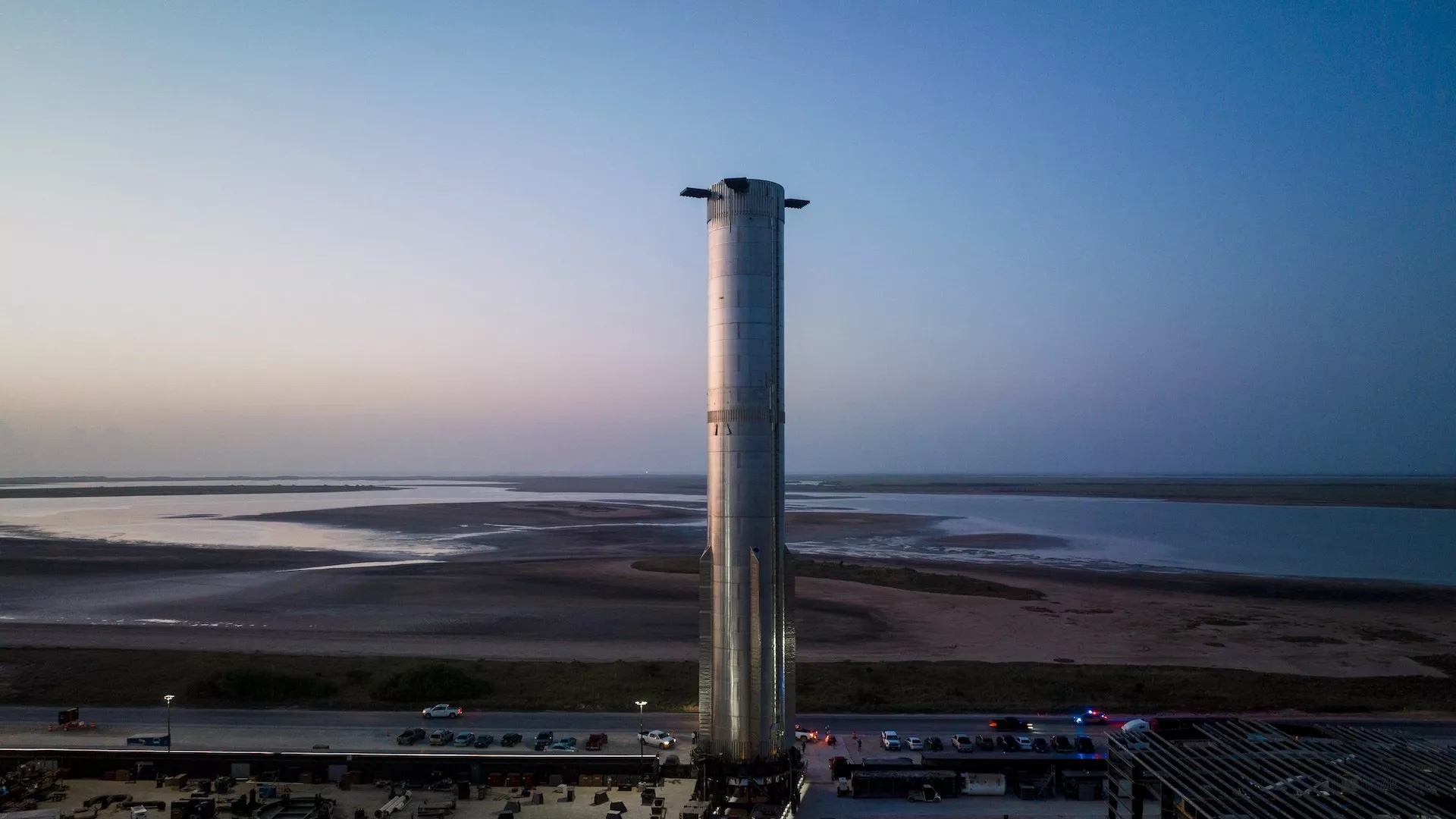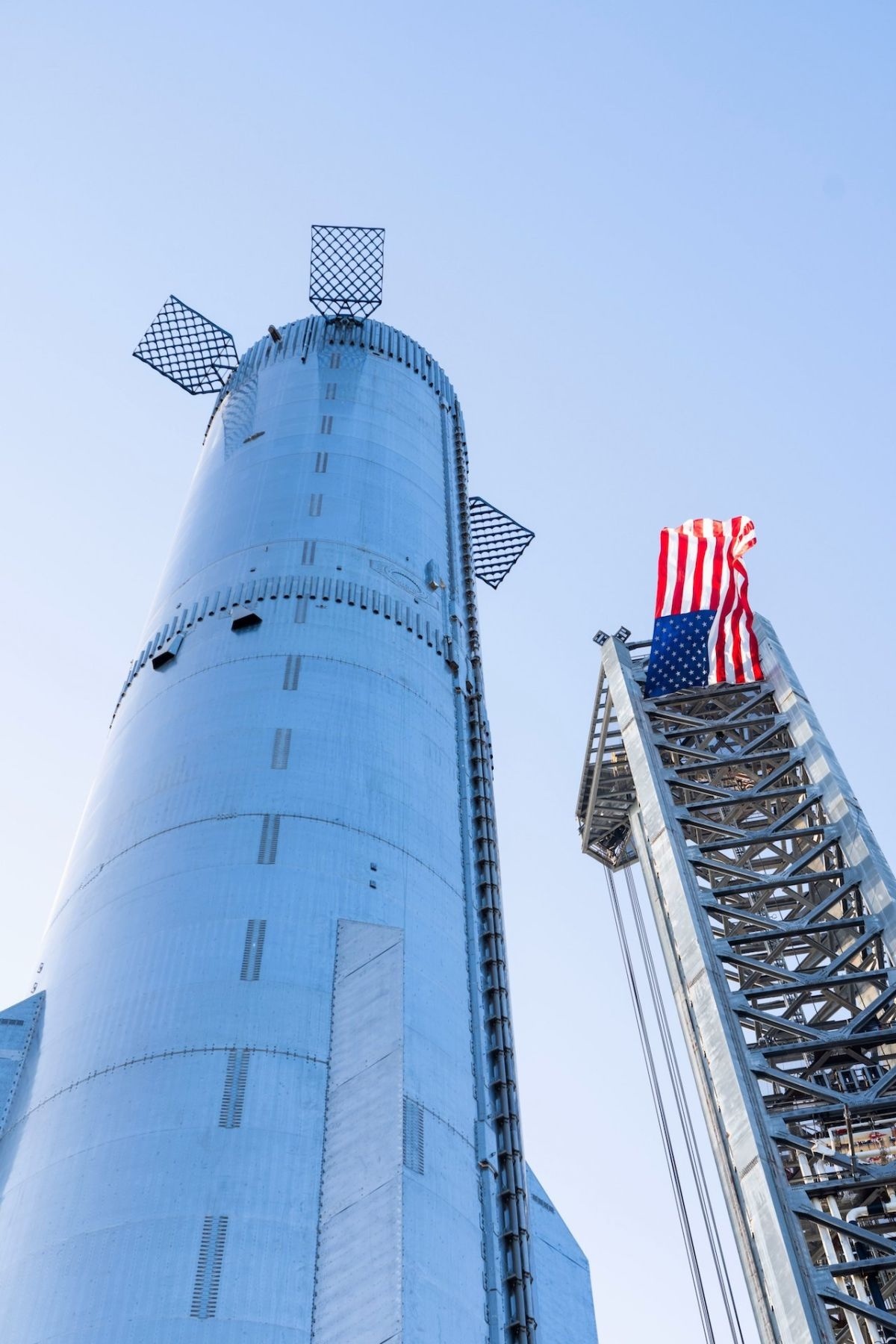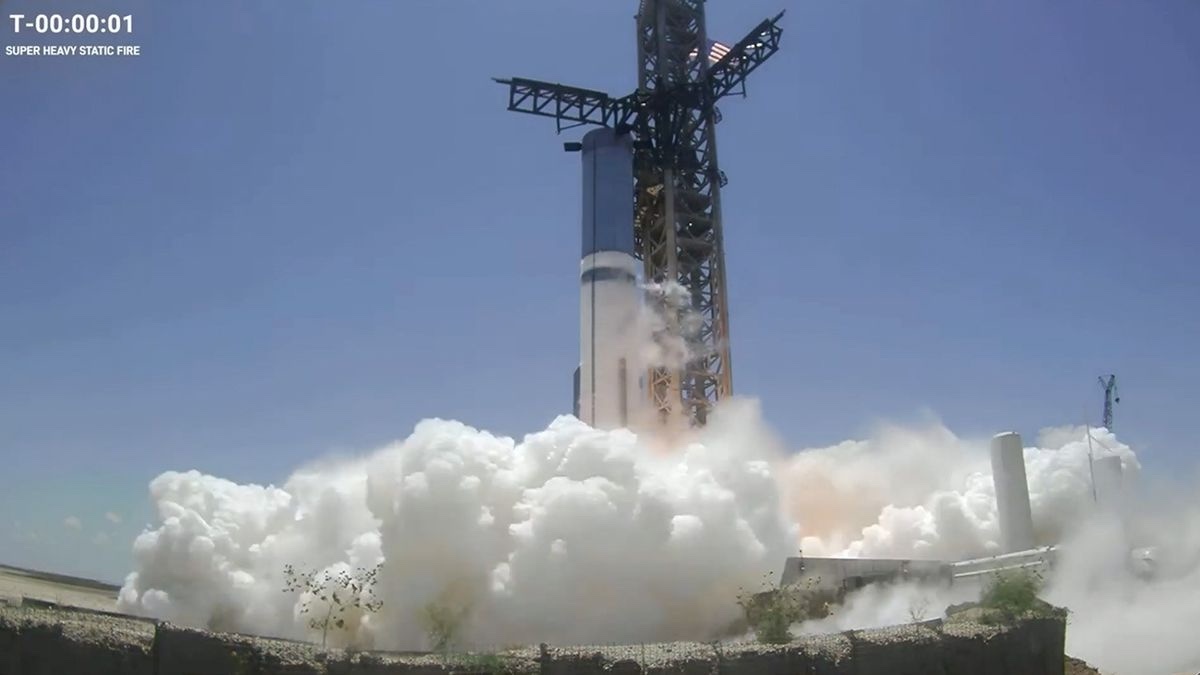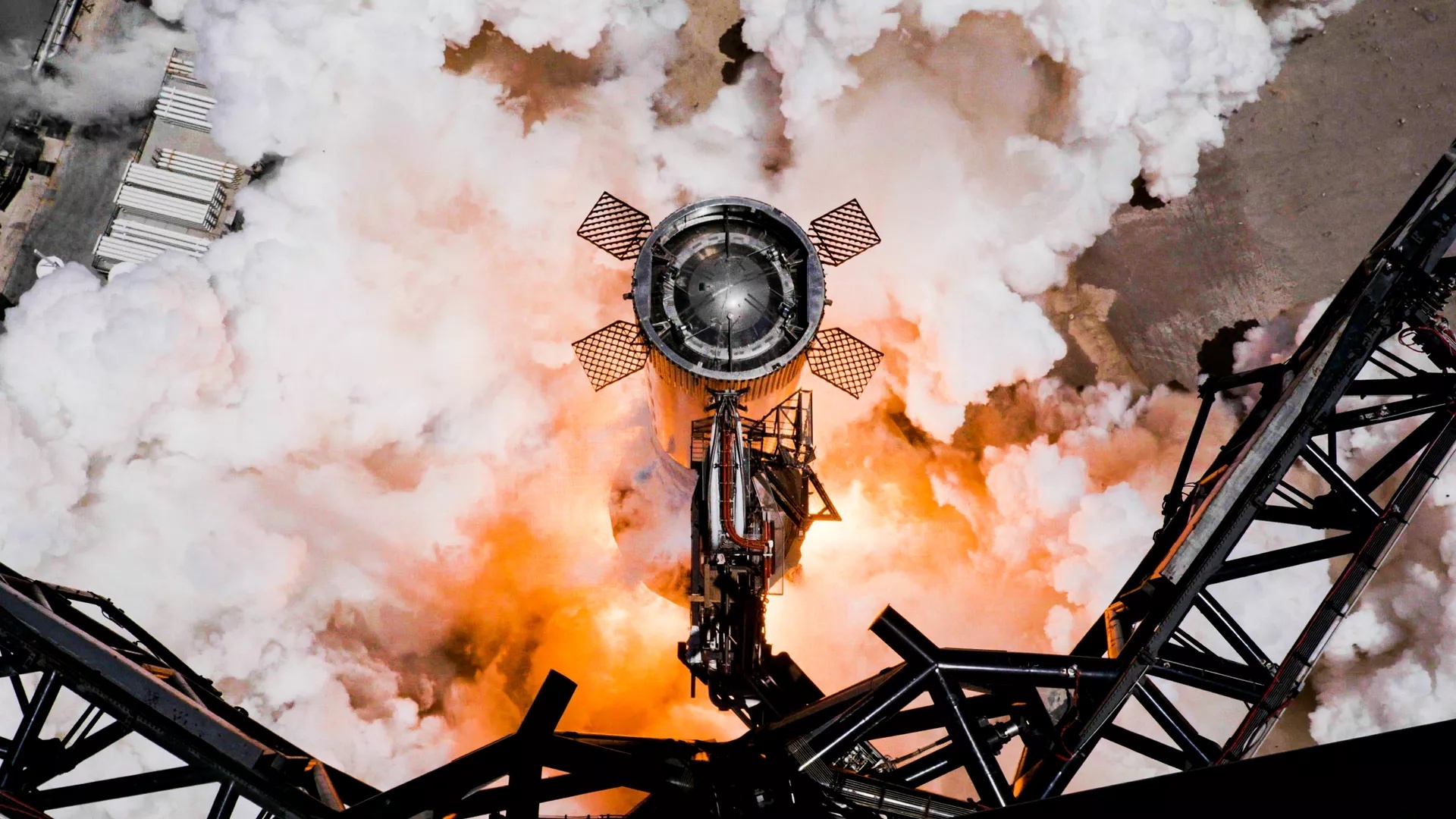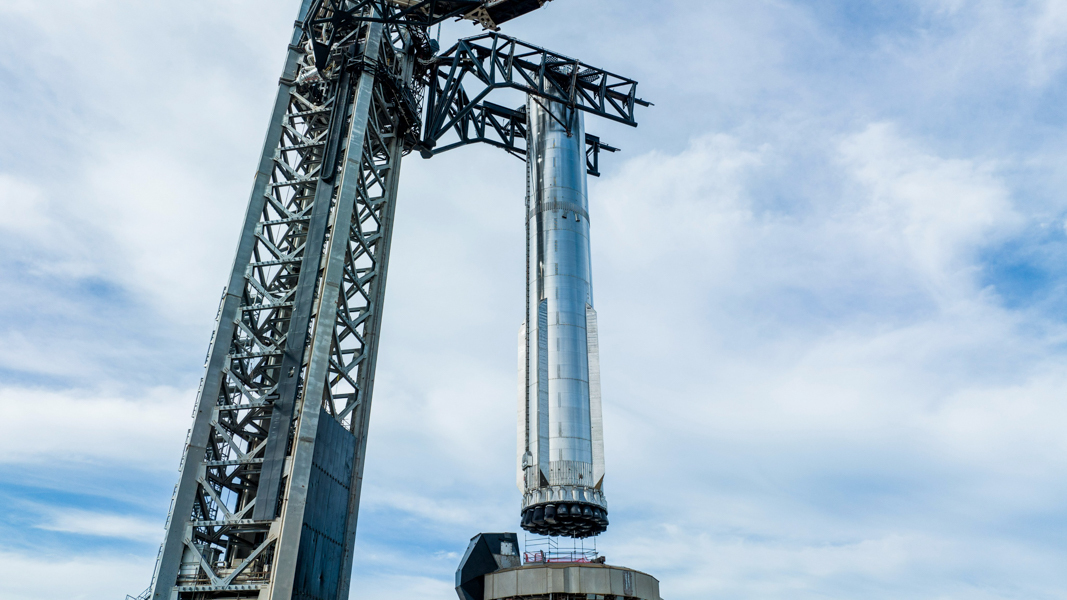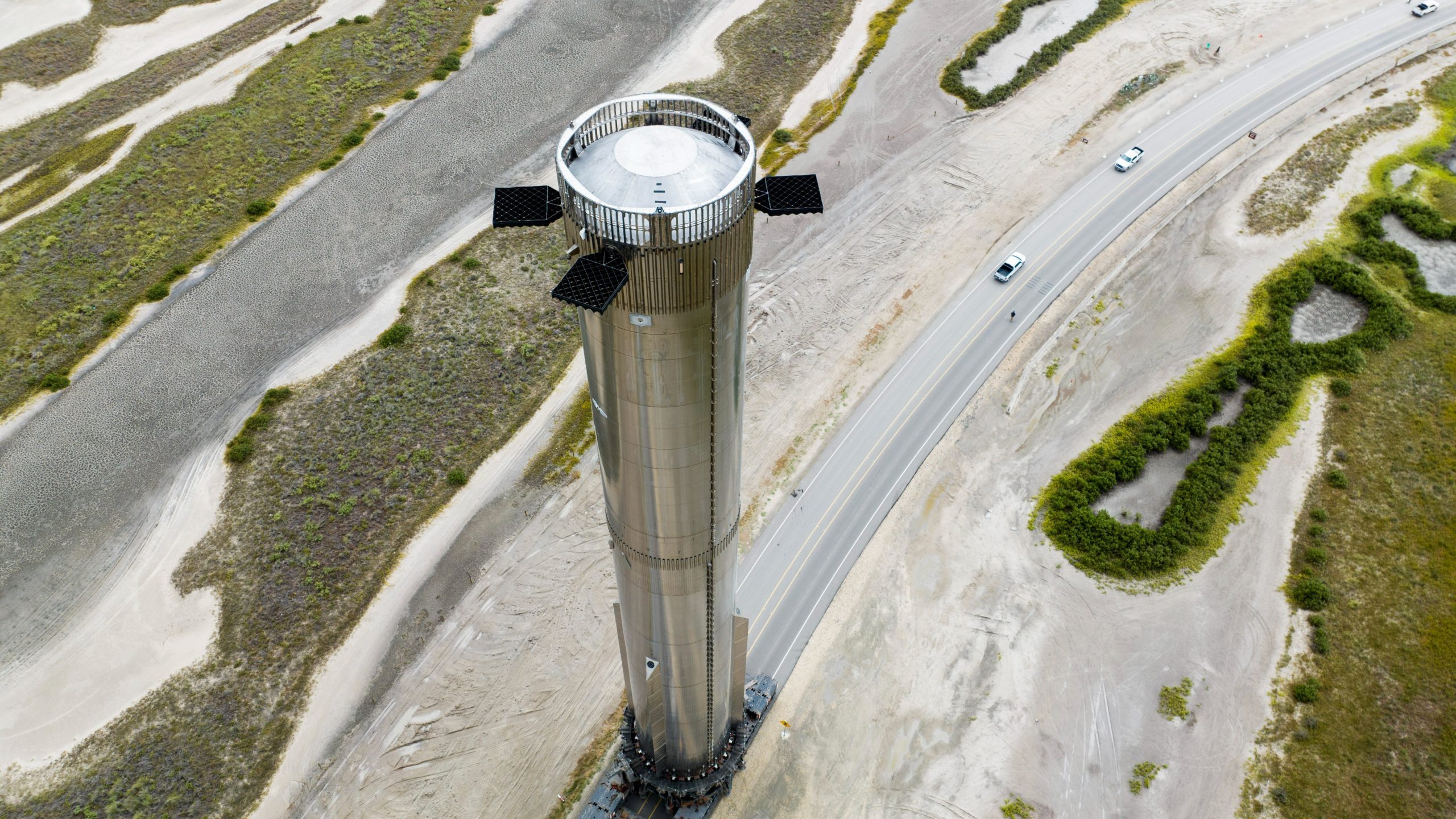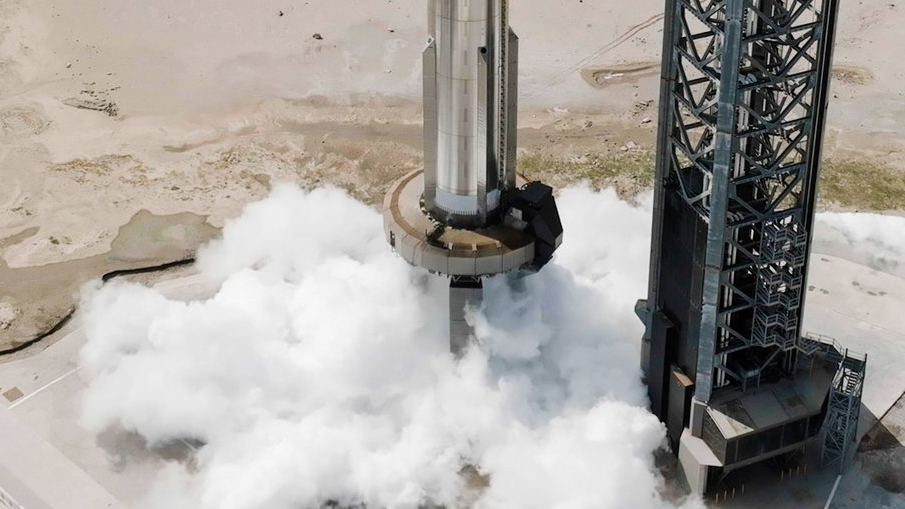23.06.2023
Ship 25 begins engine testing as Starship launch pad work continues
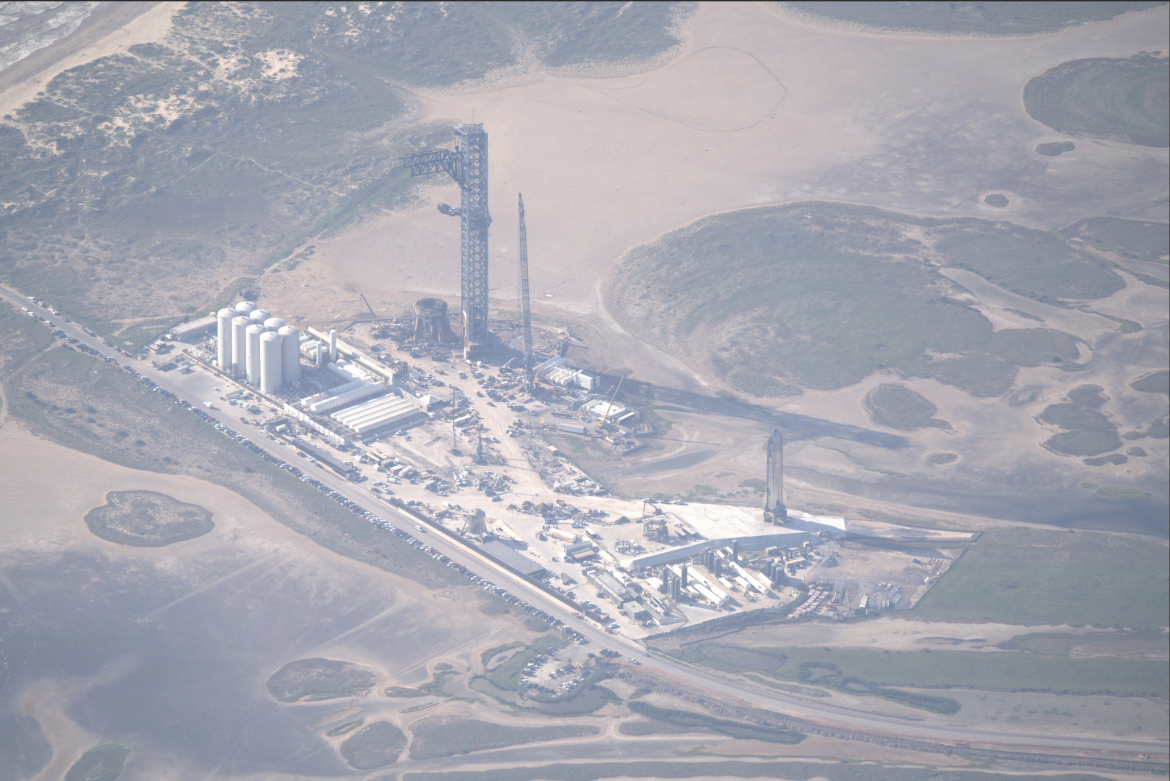
Two months after Starship’s first integrated test flight, engine testing is already underway for Ship 25, the ship that will fly on the second launch of Starship. At the same time, SpaceX is approaching the final stretch of completing the foundation work needed at the orbital launch mount (OLM) from where Super Heavy and Starship are set to lift off again no earlier than August. Ship 25 conducted a Spin Prime test on Wednesday.
Work is also at a good pace to upgrade and update Starship’s production facilities at Starbase. This has come at the expense of once more changing the company’s plans for Starship in Florida.
Ship 25 engine test campaign begins
In preparation for the second integrated flight test of Starship, SpaceX teams have been readying Ship 25 for its engine test campaign. This series of testing is aimed at qualifying the vehicle for that flight and includes everything from a spin prime test all the way to a six-engine static fire test of the vehicle’s Raptor engines.
Work ahead of this test campaign included applying slight modifications to the ship’s engine shielding and internal tank structure based on lessons learned during the first flight. For this, the SpaceX LR11000 crane was attached to Ship 25’s nosecone to provide structural rigidity to its tanks.
Once all the work was completed, the crane was disconnected from the ship, and the aft flaps were unstrapped. The first test day, June 14, saw the loading of propellants onto the vehicle ahead of what was expected to be a spin prime test. During this test, the engine oxidizer pump is spun up to full power — simulating the start-up sequence of the engine without any actual ignition.
However, close to the test T0 an abort was called and the vehicle was detanked. A new attempt resulted in the test being completed on Wednesday.
It is likely that multiple spin prime tests will be performed ahead of the static fire tests. It should — hopefully — only be a matter of weeks until the ship modifications are finally tested and the engines qualified for flight.
OLM rebar work and upcoming concrete pour
None of Ship 25’s testing would be valuable without a launch pad where the full Starship stack could launch from. During the first integrated test flight of Starship, Super Heavy Booster 7’s 30 working engines dug a sizable hole under the OLM during liftoff.
The first images of it pictured a dramatic scene and pointed at some tough repair work ahead for SpaceX teams. Over the last two months, the hole was covered and reinforcements have been installed deep into the ground to strengthen the soil.
More recently, teams have been installing several tons of rebar underneath the OLM. While some rebar remains to be installed, as seen from aerial pictures captured by NSF, this work is expected to be finished soon and should be followed by a convoy of concrete trucks to fill up the pit.
SpaceX will then install water-cooled steel plates over this concrete which will help support them and serve as an anchor for them.
These steel plates are currently being worked on near the propellant production site, often also called the Sanchez site. While six plates are needed to be installed between the columns of the OLM, only three are planned to carry the big water manifolds that were seen transported from Florida earlier this year.
Of these three, two of them are now almost complete with a third one still undergoing extensive work to be ready for installation.
Additionally, a new set of water tanks have been added to the back side of the launch tower at the launch site. Here, six water deluge tanks have been installed over the past months and a new set of high-pressure tanks have now been stacked and installed as well.
More recently, teams have installed two large pipes that connect the water tanks with the pipes leading up to the OLM. These two pipes bend upward and then downward, indicating that perhaps not only the tanks will be filled with water but also the length of the pipes leading up to that bend.
Without pressure, the water would not be able to keep flowing past the bend and would remain stationary. Once pressure is applied via the high-pressure tanks, the water will be able to overcome the bend and flow through the pipes all the way to the plates under the OLM.
Vehicle production status at Starbase
While SpaceX continues working on the launch pad facilities, production is still in full swing at Starbase.
This includes the completion of stacking for Ship 29 in the High Bay and Booster 11 inside the Mega Bay as well as the start of stacking for Booster 12.
While Ship 29’s stacking is now complete, work remains ahead to complete the vehicle. Its stablemate inside the High Bay, Ship 28, also saw the removal of its payload bay door. This is unlike the work performed on Ship 24 and Ship 25 to seal their payload bay doors. On the contrary, it seems like this could be to change the current design or just upgrade it.
Parts for Ship 30, the next ship in the line of production after 29, have also been staged at the “ringyard” near the High Bay. A new set of vent-like structures can be observed on Ship 30’s nosecone which may indicate the addition of new vents to act as thrusters on this part of the vehicle. However, it is still too early to tell for certain.
In the Mega Bay, Booster 11 completed stacking earlier this month and work is already well underway for stacking Booster 12. The latter vehicle’s LOX tank is now complete and is only missing the engine section. Stacking of the vehicle’s methane tank started as early as June 15 and, at the current pace, will likely be complete before the end of the month.
Starship’s new production facilities at Starbase
In the last weeks, SpaceX has completely dismantled the ground fabrication building. Aerial shots indicate it might be rebuilt at the Sanchez site as can be seen by the presence of new foundations similar in size to that of this building.
During that time, teams started installing the first beams and columns of the Starfactory building expansion. The full outline of the future expansion has been made apparent, taking up the space where the ground fabrication building, propulsion building, and windbreak once stood.
The new Mega Bay building has also grown in size in the last few weeks, now having its first two levels completed. At least two corners for the third level are nearly complete as well and the third and fourth corners follow closely.
Plans for Starship from Florida change once more
While vehicle production continues strong at Starbase and new facilities are built, the same cannot be said of the Starship facilities in Florida.
Work on the second set of tower sections, chopsticks, carriage system, and QD arm at SpaceX’s Roberts Road facility has come to a halt. Contractor equipment has visibly disappeared and other construction equipment has been removed.
The Florida Mega Bay parts have also made their way to Starbase, becoming the second Mega Bay at the Texas facility. The two big cranes that were previously at Roberts Road were also moved to Starbase to aid in the construction of that new Mega Bay.
On top of this, SpaceX has changed the use of the building previously thought to be the factory for Starship sections. This facility is now being used to process Starlink payload integration with Falcon 9’s fairings. The facility was first used to integrate satellites for the Starlink Group 6-4 mission earlier this month.
Despite this, work is still underway on the Starship launch pad at Launch Complex 39A where cranes and aerial work platforms continue construction on the site. Even though this work has slowed down, its continuation means SpaceX likely has no plans to retire all Starship efforts from Florida.
Without a production facility in Florida, vehicles set to fly from the Space Coast would need to arrive from Starbase, increasing the production demand at the Texas facility. This means that the vast expansion of the production buildings at Starbase could have been at the expense of removing production from Florida for the time being until Starship’s design is reliable and proven.
Quelle: NSF
----
Update: 26.06.2023
.
SpaceX changing Starship stage separation ahead of next launch
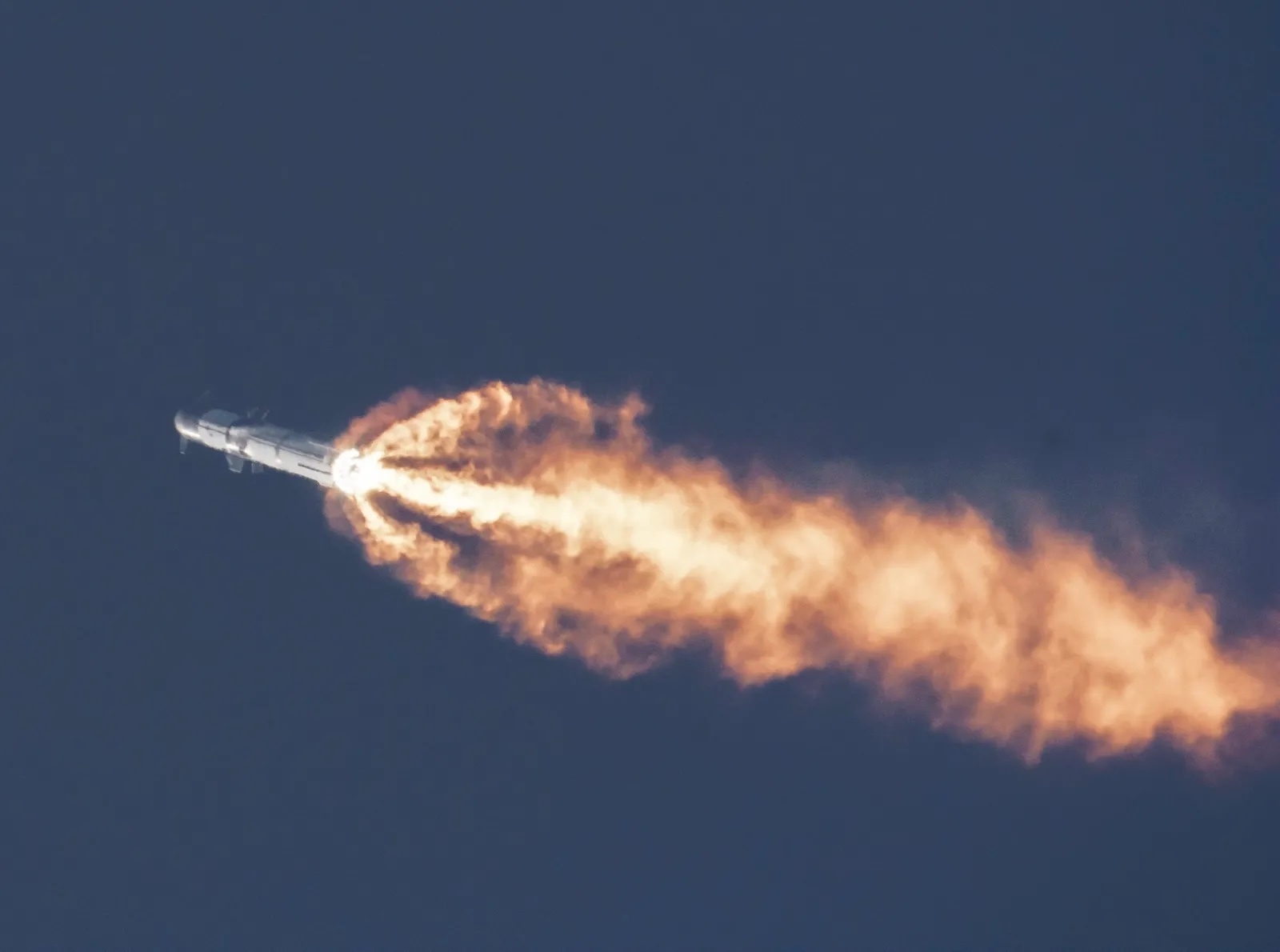
WASHINGTON — SpaceX is changing the approach for separating the two stages of its Starship vehicle to increase payload performance before its next test flight, Elon Musk said June 24.
In an online discussion with Bloomberg journalist Ashlee Vance on Twitter, the social media company Musk owns, he said that SpaceX had recently decided to switch to a “hot-staging” approach where the Starship upper stage will ignite its engines while still attached to the Super Heavy booster.
“We made sort of a late-breaking change that’s really quite significant to the way that stage separation works,” Musk said, describing the switch to hot staging. “There’s a meaningful payload-to-orbit advantage with hot-staging that is conservatively about a 10% increase.”
Hot-staging, which has been used on Russian launch vehicles for decades, involves igniting the engines on one stage while still attached to its lower stage. Musk said that, for Starship, most of the 33 Raptor engines on the Super Heavy booster would be turned off, but a few still firing, when the engines on the Starship upper stage are ignited. Doing so, he said, avoids the loss of thrust during traditional stage separation, where the lower stage shuts down first.
Doing so requires some modifications to the Super Heavy booster. Musk said SpaceX is working on an extension to the top of the booster “that is almost all vents” to allow the exhaust from the upper stage to escape while still attached to the booster. SpaceX will also add shielding to the top of the booster to protect it from the exhaust.
“This is the most risky thing, I think, for the next flight,” he said of the new stage separation technique.
Besides the change in stage separation, Musk said SpaceX made a “tremendous number” of other changes to the vehicle, “well over a thousand.” He didn’t go into details about the changes, but did note the company was continuing work to upgrade the launch pad to avoid the damage caused by the first Starship launch April 20, such as a “steel sandwich” water deluge system. “We’re actually going for overkill on the steel sandwich and the concrete, so that should leave the base of the pad in much better shape than the last time.”
SpaceX also made improvements to the Raptor engines, with Musk describing the vehicle launching in April as using a “hodgepodge” of engines built over time. The Raptors on the new vehicles include changes to the hot gas manifold in the engine to reduce fuel leakage.
Those changes, he said, gave him more confidence in the success of the next launch. “I think the probability this next flight working, getting to orbit, is much higher than the last one. Maybe it’s like 60%.” In an online conversation in late April, he estimated a “better than 50% chance” of success on the next launch.
Musk did not commit to a specific launch date. “A lot of variables here that are outside of our control,” he said, an apparent reference to the Federal Aviation Administration launch licensing process. “We think, probably, the launch pad upgrades, and the booster and ship, are ready in about six weeks.” Musk, in that April conversation, said he expected to be ready to fly “in a couple months.”
No comment on Starlink IPO
Earlier in the conversation, Musk declined to comment on recent rumors that SpaceX was considering spinning out its Starlink satellite broadband business and conducting an initial public offering (IPO) of stock in it. Fox Business reported June 21 that SpaceX investors anticipated a spinout and IPO of Starlink this year so that Musk could raise money for other ventures, like Twitter.
Musk, asked about any plans for a Starlink IPO, declined to comment. “It would not be legal for me to speculate about a Starlink IPO,” he claimed. “I think it’s against regulations to talk with any kinds of specifics about a future public offering.”
Musk has previously played down any talk about spinning out Starlink and taking it public. He said in 2020 he was “thinking about that zero” in order to focus on making the broadband service a technical and financial success.
In an internal company meeting in June 2022, Musk said he did not know when SpaceX would take Starlink public, but estimated it would be at least three to four years.
Quelle: SN
----
Update: 5.07.2023
.
SpaceX, FAA ask for dismissal of suit seeking new environmental assessment of Starship launches
Texas, national environmental and indigenous groups sued after SpaceX's first launch from Boca Chica ended in explosion
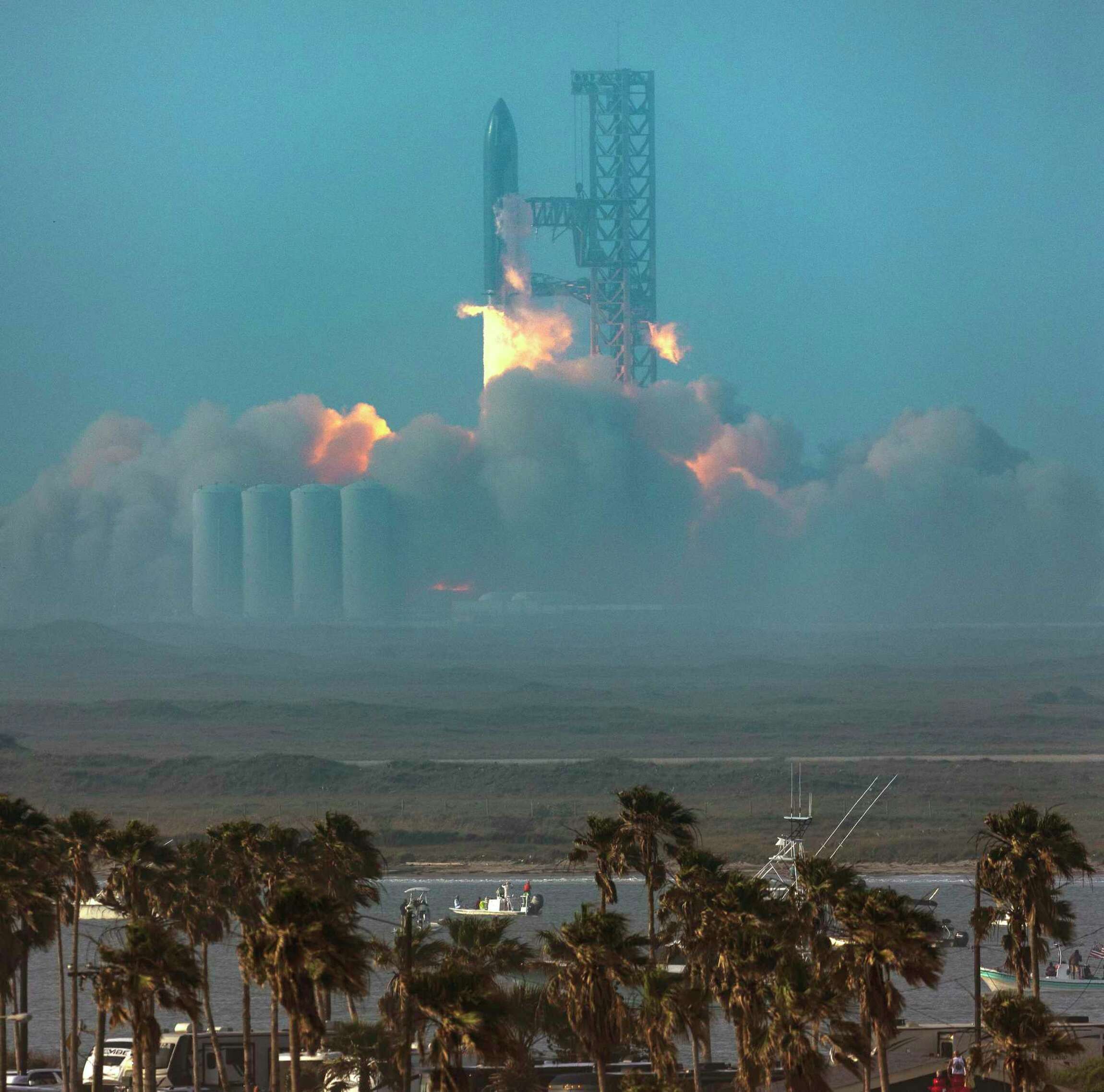
SpaceX’s Starship and Super Heavy rocket system take flight Thursday. While the flight and explosion were spectacular, environmental concerns abound.
William Luther, Staff / Staff
SpaceX and the Federal Aviation Administration are asking a federal court to dismiss a lawsuit by environmental and Indigenous groups seeking a new assessment of the environmental impacts of rocket launches from South Texas.
In a filing Friday, the FAA said the groups lack legal standing for their claims against the agency that granted a launch license to SpaceX’s Starship rocket program. Separately, a SpaceX filing said the first Starship launch on April 20provided no cause for the FAA to conduct a new environmental assessment, a process that could halt further test launches for years.
“For the foregoing reasons, defendants request that the court dismiss the complaint in its entirety,” Todd Kim, assistant attorney general for the environment and natural resources division of the U.S. Department of Justice, wrote in the filing in U.S. District Court in Washington, D.C.
Both are seeking to dismiss a lawsuit filed May 1 by the Center for Biological Diversity, American Bird Conservancy, SurfRider Foundation, Save Rio Grande Valley and the Carrizo-Comecrudo Nation of Texas. It alleged the FAA should have conducted a more in-depth environmental study on the likely impacts of SpaceX activity before allowing it to launch from its Starbase facility at Boca Chica. They also alleged the mitigations the FAA required were not enough to avoid “significant adverse effects” to endangered species, their habitat and tribes in the area that count the land and wildlife sacred.
Their suit seeks to revoke the company’s FAA-issued license for flights from South Texas. The license is currently suspended during an investigation into the launch, which public and private assessments found sparked wildfire, spread chunks of metal and concrete over hundreds of acres of company-owned and state park land and propelled “pulverized concrete” more than 6 miles.
In Friday’s filing, SpaceX denied Starship is a danger to surrounding wildlife and communities that should have received more review. It also noted that the company’s program passed an environmental assessment and complied with FAA-required mitigations. It said it launched Starship “in accordance” with its FAA license, and that the rocket system “successfully lifted off and flew for several minutes before experiencing anomalies that resulted in the termination of the mission and safe destruction of the launch vehicle over the Gulf of Mexico.”
SpaceX also appeared to downplay the rocket’s impacts on its surroundings. “SpaceX admits that the concrete launch pad deck was damaged during the liftoff, spreading some debris and dust,” it said.
After Starship’s explosion, the FAA said the “anomaly response plan” referenced in its environmental assessment was activated, which means a new license will be required before another launch.
In its filing, SpaceX said the environmental assessment “has not been withdrawn or modified” and the company is “working toward another launch” of Starship.
SpaceX CEO Elon Musk has continued to tout an aggressive schedule of test launches from South Texas. He’s pinned hopes on the reusable rocket system to expand the company’s Starlink network of satellites and for NASA’s plans for returning astronauts to the moon. It also serves as a vehicle for Musk’s long-term goal of populating Mars.
On June 13, Musk tweeted Starship would be ready to launch within six to eight weeks.
In an interview on Twitter, Musk on June 24 told reporter Ashlee Vance the company has made more than 1,000 changes to the rocket’s design since April 20, including adaptations to separate the Super Heavy booster from the upper stage known as Starship. The test flight failed to separate the rocket system and it exploded as one unit. Typically, SpaceX fires the upper stage Raptor engines after lighting those on the booster. But now, the company is aiming to use “hot staging,” Musk said, a technique that involves simultaneously firing up engines on both stages — which would increase thrust power.
Two days later, SpaceX said it successfully completed “a six engine static fire test” on the upper stage Starship prototype Ship 25 at Boca Chica.
Despite SpaceX’s schedule claims, NASA has been wary of the company’s ability to conduct test flights needed to have its lunar lander version ready to carry astronauts to the moon. In early June, it said its Artemis 3 moon mission planned for late 2025 is likely to be postponed until 2026.
“With the difficulties that SpaceX has had, that’s really concerning,” said Jim Free, NASA’s associate administrator for exploration systems development.
It did not mention the lawsuit filed by the environmental groups.
SpaceX joined the FAA as a co-defendant in the lawsuit to protect its business. The company has said it invested $3 billion into developing the Starbase facility since 2014, and Musk recently said he expects the company will spend about $2 billion on Starship development this year.
“If the Court were to rule in Plaintiff’s favor, the FAA’s decision could be set aside, and further licensing of the Starship/Super Heavy Program could be significantly delayed, causing severe injury to SpaceX’s business,” the company wrote in a motion filed May 19.
Quelle: The San Antonio Express-News
----
Update: 23.07.2023
.
SpaceX rolls Starship Super Heavy booster back to the pad ahead of next launch (photos)
Quelle: TESLARATI
----
Update: 26.08.2023
.
Super Heavy Booster 9 static fire successfully lit all 33 Raptor engines, with all but two running for the full duration. Congratulations to the SpaceX team on this exciting milestone!
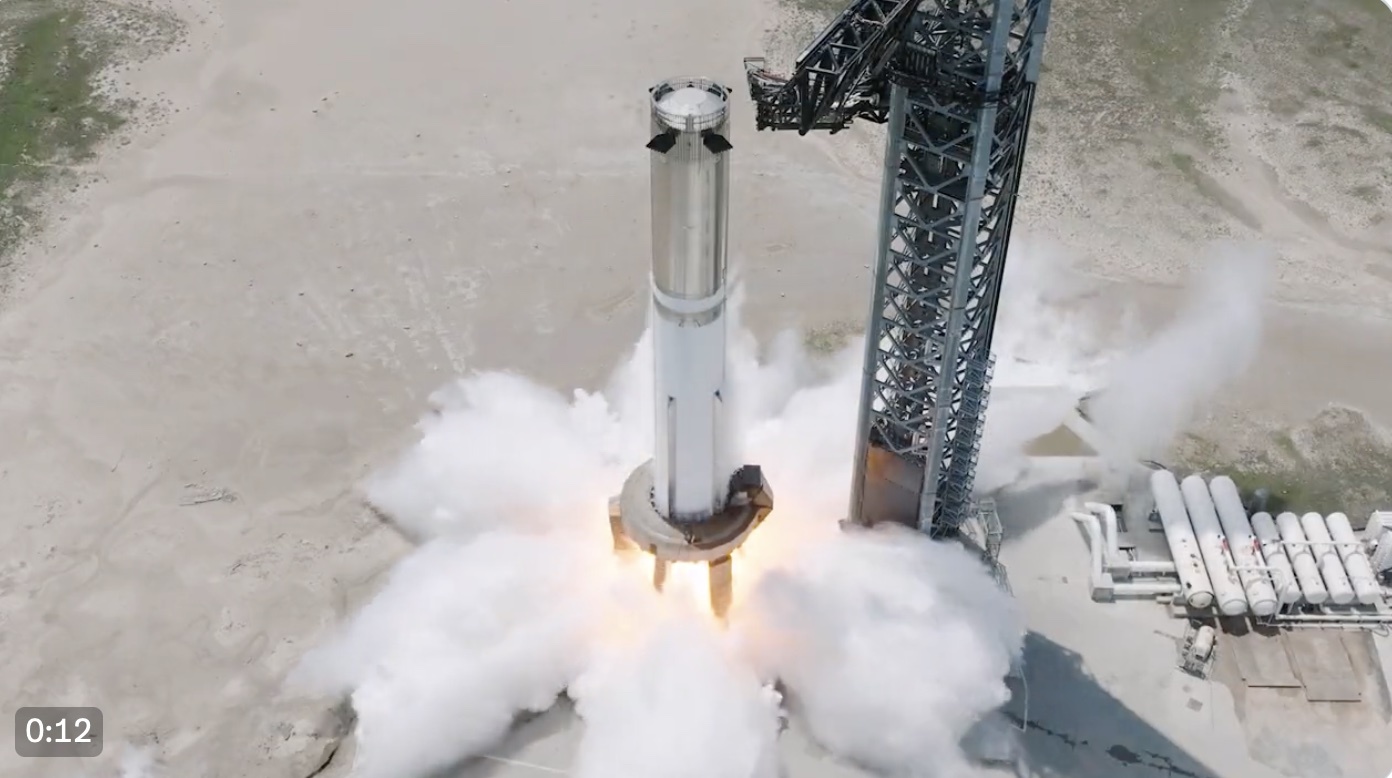
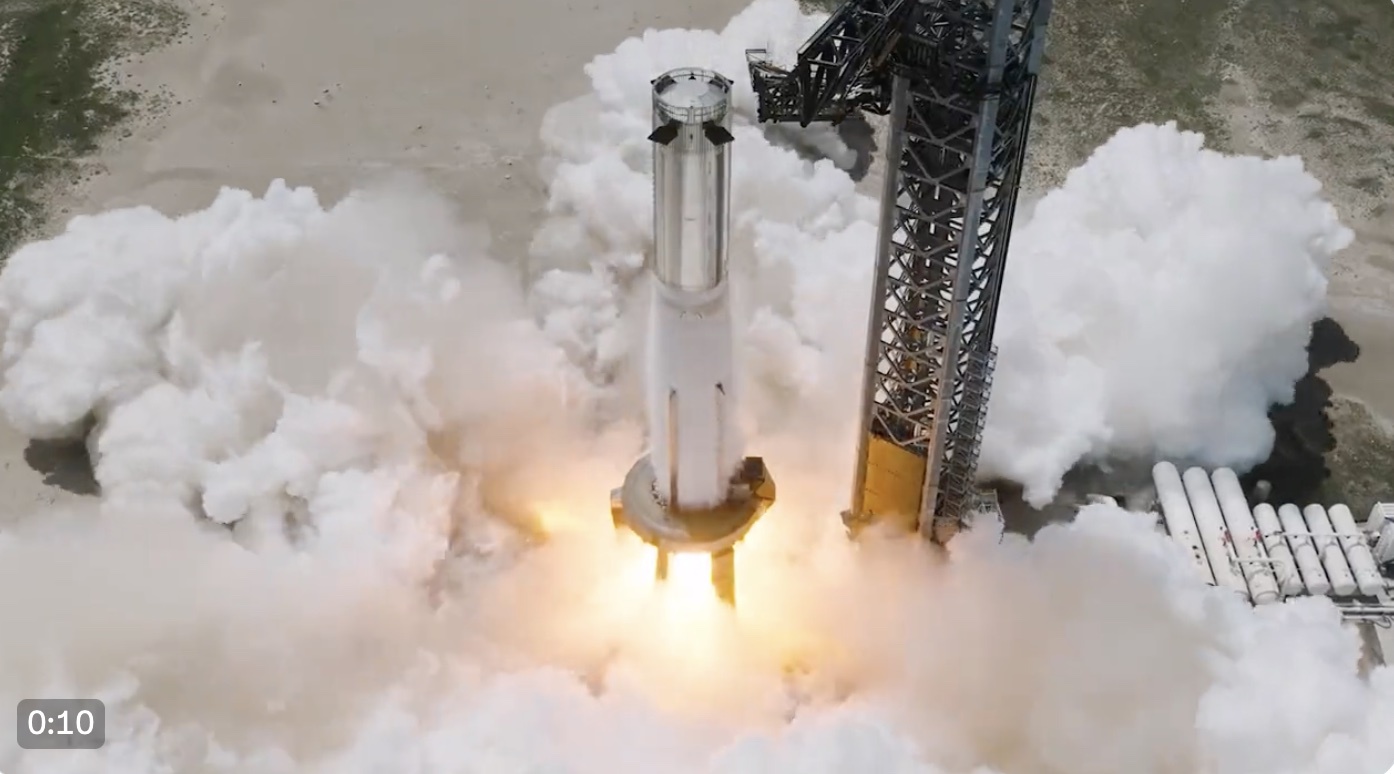
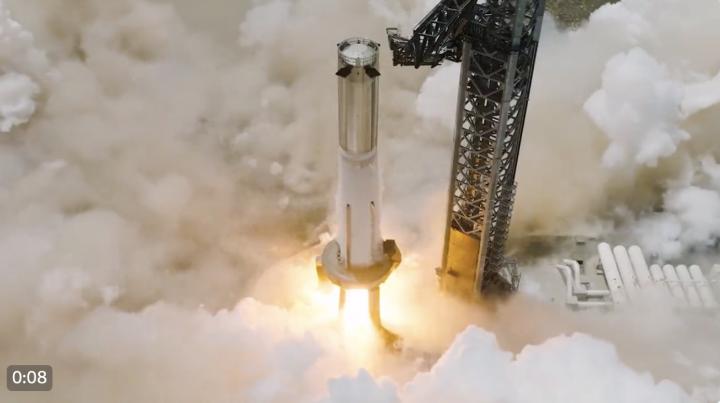
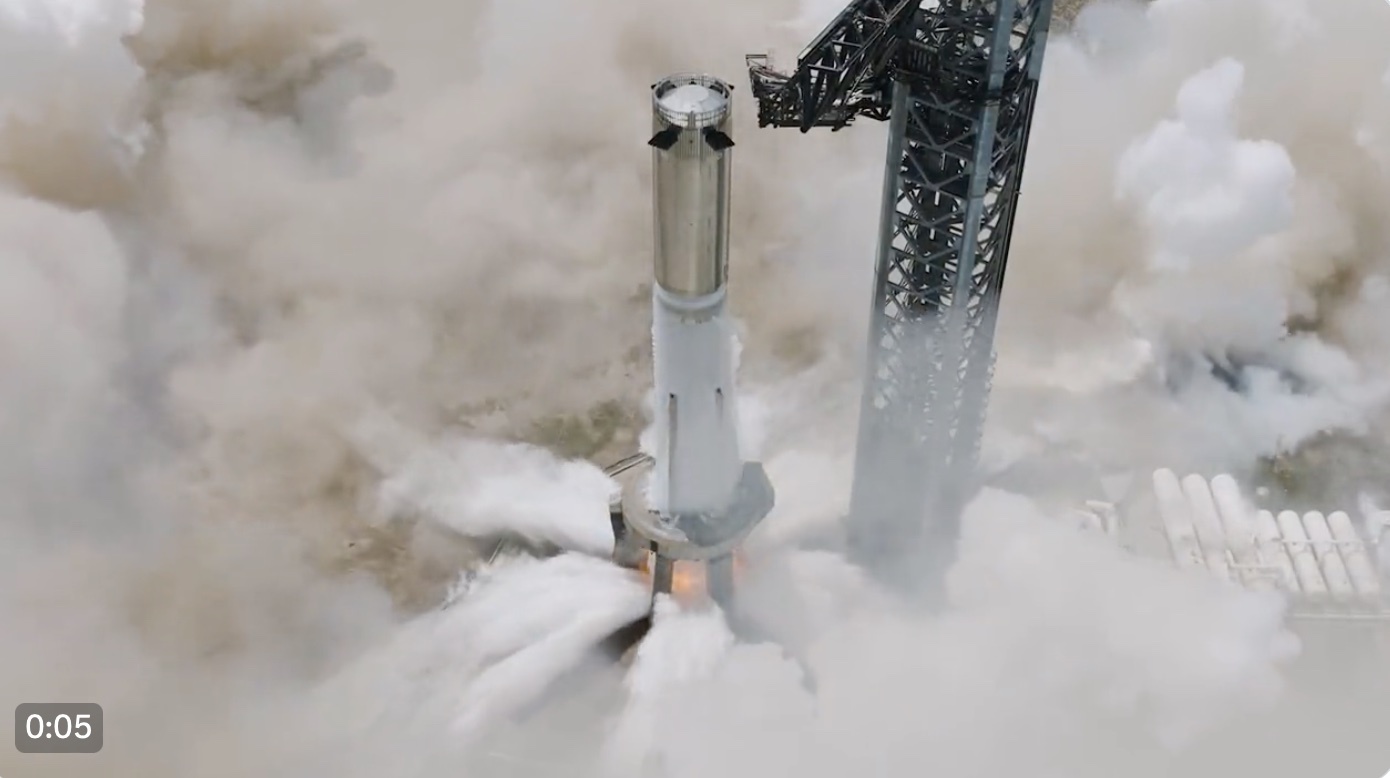
Quelle: SpaceX
----
Update: 8.09.2023
.
Musk declares Starship is ready for its second test flight, following stacking
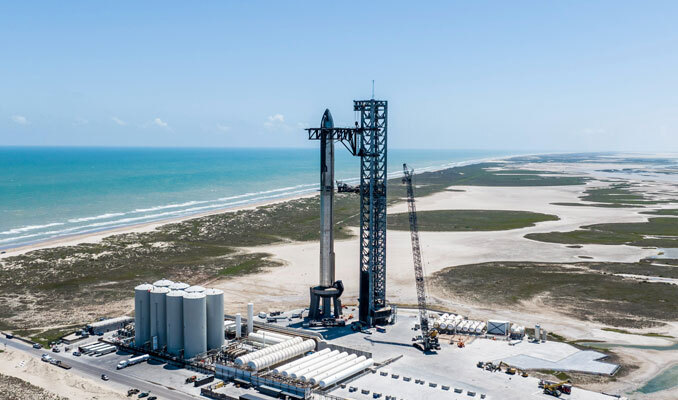
Aerial view of the fully stacked Starship vehicle at Starbase, Texas, on Sept. 6, 2023. Image: SpaceX.
Story updated with information confirmed to Spaceflight Now by the Federal Aviation Administration on Sept. 7, 2023.
Another SpaceX Starship rocket stands fully integrated against the South Texas horizon and company-founder Elon Musk said from his perspective, they’re ready to launch.
Over the course of several hours on Tuesday at its test facility near Boca Chica Beach, SpaceX teams hoisted the Starship upper stage of the rocket, S25, on top of the Super Heavy Booster, dubbed Booster 9 or B9, that was already on the launch mount.
Following the operation, Musk took to his social media platform, X, to declare that “Starship is ready to launch, awaiting [Federal Aviation Administration] license approval.”
While some aviation and marine warning notifications suggest launch could be somewhat soon, the second clause of Musk’s post will be the great determinative factor of when the second launch of a fully integrated Starship rocket will actually take place.
SpaceX submitted its final mishap investigation report to the FAA over the summer, following it’s unsuccessful launch attempt on April 20. It’s part of the SpaceX-led mishap investigation that is being overseen by the FAA.
An agency spokesperson told Spaceflight Now in a statement on July 28 that its oversight is “to ensure SpaceX complies with its FAA-approved mishap investigation plan and other regulatory requirements.”
“A mishap investigation is designed to further enhance public safety. It will determine the root cause of the event and identify corrective actions the operator must implement to avoid a recurrence of the event,” the spokesperson said.
Because of their interests as well, both NASA and the National Transportation Safety Board (NTSB) also have official observer status to the investigation.
How soon is Starship FT2?
Since its first launch in the spring, SpaceX has been busy making updates to both its Starship rocket as well as the infrastructure around the launch pad.
They added a water deluge system at the base of the orbital launch mount to protect the pad from the damage seen during the first launch attempt.
Teams also added a hot staging ring to the top of the Super Heavy booster to alter the way that the first and second stages of the rocket separate during its ascension.
It’s unclear what additional updates and requirements the FAA will require from SpaceX prior to the agency granting Starship another launch license. The timeline is no more certain.
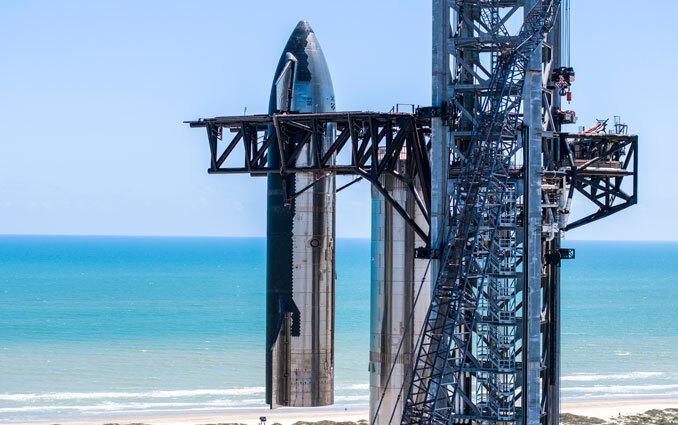
Starship 25 is lifted atop Super Heavy booster by the launch pad ‘chopsticks’. Image: SpaceX.
For instance, Blue Origin’s New Shepard rocket experienced what it described as a “thermo-structural failure on the engine nozzle” on its BE-3PM engine, which triggered the Crew Capsule escape system during its flight on Sept. 12, 2022.
At this point, the New Shepard vehicle still has not returned to flight. On Thursday, Sept. 7, 2023, an FAA spokesperson confirmed to Spaceflight Now that its mishap investigation regarding this incident has not concluded.
Regarding SpaceX’s Starship rocket, the FAA stated that its mishap investigation is also still ongoing with no specific timeline.
“The SpaceX Starship mishap investigation remains open. The FAA will not authorize another Starship launch until SpaceX implements the corrective actions identified during the mishap investigation and demonstrates compliance with all the regulatory requirements of the license modification process,” the agency stated.
There is also the outstanding lawsuit brought by the Center for Biological Diversity, the American Bird Conservancy, Surfrider Foundation, Save RGV (Rio Grande Valley) and the Carrizo/Comecrudo Nation of Texas.
According to the most recent court filing on July 25, a joint status report is due to the U.S. District Court for the District of Columbia by Oct. 27, 2023.
Jared Margolis, the lead attorney for the CBD, told Spaceflight Now in a statement on Sept. 6 that the administrative record is set to be filed by the end of September. After the contents of the record are agreed upon, dates for filing summary judgment motions will be established, likely taking place over the fall and winter.
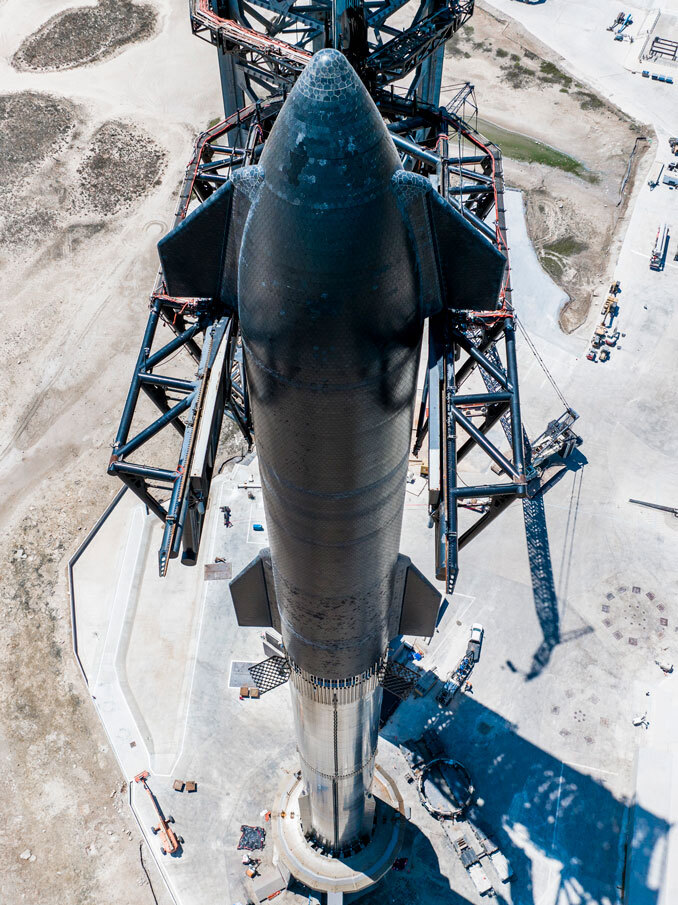
Standing tall on the Starbase launch pad, Ship 25 and Booster 9 are poised to make the second Integrated Test Flight. Image: SpaceX.
Margolis added that they are also looking at other options “if the FAA allows SpaceX to continue with additional launches before they have complied with the requirements of NEPA (National Environmental Policy Act), including a supplemental analysis to address the [April 20] launch explosion and the subsequent changes to the launch program.”
“As far as the recent tests and the potential for another launch, we believe that such activities violate the National Environmental Policy Act and the Endangered Species Act, both of which require supplemental analysis as described above, and preclude such activities while the supplemental analysis is pending to preserve the status quo,” Margolis told Spaceflight Now. “We therefore remain very concerned that FAA has not made clear that no further launches will be permitted until all applicable environmental laws are complied with.”
Spaceflight Now reached out to the FAA for clarification, but has not yet heard back as of publication.
It’s unclear if, like the FAA mishap investigation, the FAA will require the resolution of the lawsuit before the second test flight of Starship.
Quelle: SN
+++
SpaceX is not yet cleared for another Starship Super Heavy test flight, FAA says
- The Federal Aviation Administration said Wednesday that SpaceX is not yet clear for another test flight of its Starship Super Heavy launch vehicle.
- Following a Starship Super Heavy explosion in April 2023, the FAA is conducting a mishap investigation, a standard practice after a “launch anomaly” of such magnitude.
- SpaceX will not be authorized to test its 400-foot-tall rocket again until that investigation is complete, and the company takes required corrective actions as determined by the FAA.
The Federal Aviation Administration on Wednesday that SpaceX is not yet clear for another test flight of its Starship Super Heavy launch vehicle.
SpaceX CEO Elon Musk had claimed Tuesday, in a post on X (formerly Twitter) which he now owns, that “Starship is ready to launch, awaiting FAA license approval.”
However, his aerospace and defense company hasn’t met the FAA’s requirements to be able to fly again after an explosion in April 2023 during the first test flight of this vehicle.
The first Starship launch saw the nearly 400-foot-tall rocket fly for more than three minutes — but it lost multiple engines, caused severe damage to the ground infrastructure and failed to reach space after the rocket began to tumble and was intentionally destroyed in the air.
The mishap left a crater in the ground, flung concrete chunks into nearby tanks and other equipment, and impacted sensitive habitat that is home to some endangered wildlife. It also sparked an approximately 4-acre fire on state park land.
The FAA will not authorize another Starship launch until SpaceX implements the corrective actions identified during the mishap investigation...
The Starship launch “anomaly” triggered a mishap investigation that will be overseen by the FAA — a standard practice by the agency, which is responsible for protecting the public during commercial space transportation launch and reentry operations.
In a statement sent to CNBC on Wednesday night, the FAA said: “The SpaceX Starship mishap investigation remains open. The FAA will not authorize another Starship launch until SpaceX implements the corrective actions identified during the mishap investigation and demonstrates compliance with all the regulatory requirements of the license modification process.”
Ars Technica first reported on the matter. SpaceX did not immediately respond to a request for comment.
In July, the FAA was asked to deliver a briefing to the Senate and House appropriations committees on their mishap report, before SpaceX conducts any future Starship Super Heavy launches.
NASA is currently reliant on SpaceX alone to transport people from the U.S. into orbit. With its Starship program, SpaceX is aiming to move heavy science equipment into orbit, and to economically transport higher volumes of cargo and people to the Moon and eventually Mars.
The Wall Street Journal reported on Tuesday that Musk, who is the largest shareholder of SpaceX, tapped a $1 billion loan from the company last year the same month he was completing a leveraged buyout of social network Twitter.
The SpaceX CEO’s relationship with state and federal regulators and with certain members of Congress is a tense one.
Musk has flouted FAA requirements in recent years, for example. The New Yorker reported that in December 2020, Musk pushed SpaceX to go against the agency’s orders and conduct a test flight of a rocket called the SN8 on a date for which the agency had explicitly barred that activity. The SN8 rocket exploded.
More recently, SpaceX conducted several tests of a new, water deluge system at the Starship Super Heavy launch site in South Texas. The system is meant to keep the company’s launch pad cool during launches.
However, SpaceX built and conducted tests of the water deluge system all without obtaining the environmental permits from the Texas Commission on Environmental Quality that would normally be required to discharge industrial wastewater at the site.
Quelle: CNBC
----
Update: 10.09.2023
.
SpaceX can't launch its giant rocket again until fixes are made, FAA says
The Federal Aviation Administration says SpaceX must take a series of steps before it can launch its mega rocket again
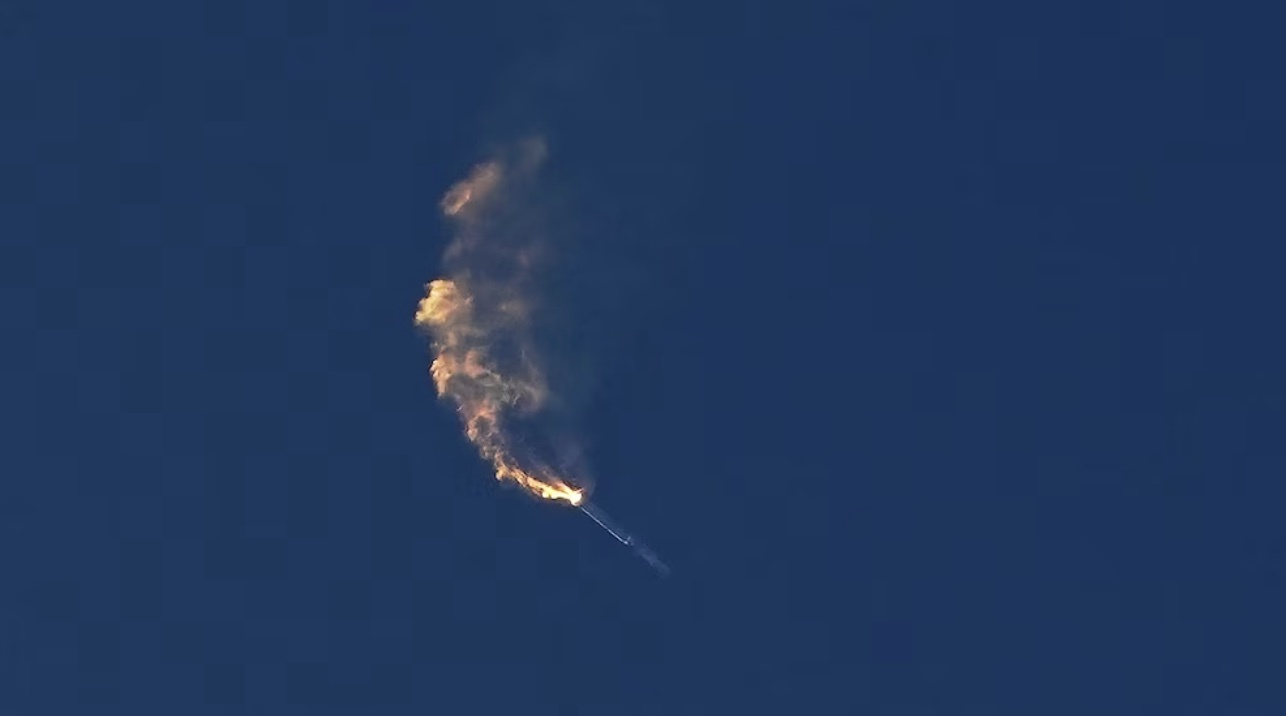
CAPE CANAVERAL, Fla. -- SpaceX must take a series of steps before it can launch its mega rocket again after its debut ended in an explosion, federal regulators said Friday.
The Federal Aviation Administration said it closed its investigation into SpaceX’s failed debut of Starship, the world’s biggest rocket. The agency is requiring SpaceX to take 63 corrective actions and to apply for a modified FAA license before launching again.
FAA official said multiple problems led to the April launch explosion, which sent pieces of concrete and metal hurtling for thousands of feet (meters) and created a plume of pulverized concrete that spread for miles (kilometers) around.
SpaceX founder Elon Musk said in the accident's aftermath that he improved the 394-foot (120-meter) rocket and strengthened the launch pad. A new Starship is on the redesigned pad, awaiting liftoff. It will fly empty, as before.
During the initial test flight, the rocketship had to be destroyed after it tumbled out of control shortly after liftoff from Boca Chica Beach. The wreckage crashed into the Gulf of Mexico. SpaceX said fuel leaks during ascent caused fires to erupt at the tail of the rocket, severing connection with the main flight computer and leading to a loss of control.
That flight “provided numerous lessons learned,” the company said in a statement.
NASA wants to use Starship to land astronauts back on the moon in another few years. Musk's ultimate goal is to build a fleet of Starships to carry people and supplies to Mars.
Quelle: abcNews


